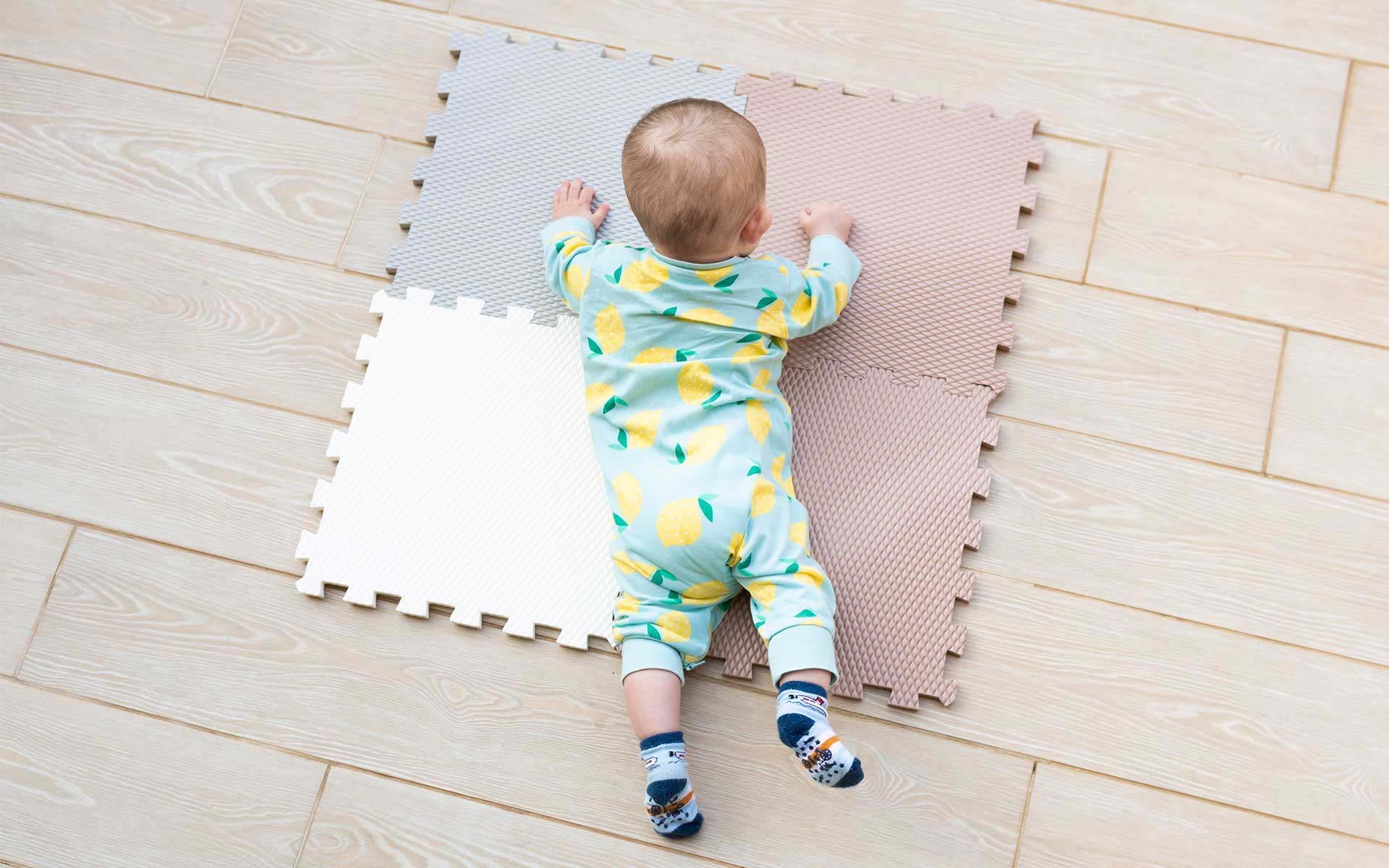
Having a baby is full of delight – and responsibility. Newborns depend on parents and caregivers to care for, teach, and help them learn and develop. So, let’s talk about tummy time, which is a cute name for an essential activity in a newborn’s development process. Most newborns fuss during tummy time because it’s new and uncomfortable being in that position (at first!). After all, their little bodies are working hard laying belly down, even if it doesn’t seem like much.
This article is definitely for you if tummy time is taxing baby’s emotions (and yours!). We’ll talk about why this activity is important for newborn development, how to do tummy time with a newborn, how often, and what to do to make tummy time a little easier for you and your baby.
What is Tummy Time?
Babies need tummy time to learn, grow and develop their muscular, skeletal, and nervous systems. This is especially true given how much time infants spend on their backs sleeping, which is the American Academy of Pediatrics’ recommended position for infant sleeping to prevent SIDS (Sudden Infant Death Syndrome).
Newborn tummy time involves placing your baby on a clean floor or mat with their belly down. When newborns fuss during tummy time, it’s because laying in that position is hard! Tummy time works new muscles babies don’t use when on their backs in the crib, stroller, or bouncer seat. Like any new workout, which is what this time is for babies, tummy time will be difficult at first. However, it will get easier for them as their bodies learn and adjust.
Benefits of Tummy Time
Tummy time has loads of benefits for newborn babies. Primarily, it strengthens your baby’s muscles in the neck, shoulders, arms, and upper torso. By encouraging this physical development, you are also preparing their bodies and motor skills for other milestones like sitting, rolling, and crawling.
Tummy time can also help prevent plagiocephaly (flat head syndrome), which happens when a baby constantly lies on its back. In addition, practicing tummy time with your baby gives them a chance to see their surroundings from a different perspective and helps stimulate developing cognitive processes.
When to Start Tummy Time?
Your baby is tummy time age right away! In fact, you can begin newborn tummy time with skin-to-skin contact while still in the hospital after birth. By holding your baby belly-to-belly with you, they can safely get used to this position while also experiencing touch. After the hospital, tummy time can continue on a safe, clean spot on the floor with a mat or blanket or while in your arms.
Pediatricians recommend aiming for a few minutes of tummy time two to three times a day. There is no such thing as too much tummy time, so do not worry about overdoing it. As your baby gets used to this time, you can begin to stretch it out by an extra 10 minutes each month until you reach about an hour (total) each day. As your baby gets used to being on their belly, tummy time will become easier for you both – even enjoyable.
How to do Tummy Time With a Newborn?
Tummy time for newborns shouldn’t be complicated, but it should be full of engagement. You can use this time as an alternative to the baby being in a carrier or bouncy seat. Although there may be fussing with tummy time in the beginning, don’t get discouraged! It will get easier the more you practice, and every minute spent doing tummy time is helpful to your baby’s development.
As we mentioned, it’s best to clear a clean space for you and your baby to interact on the floor. Once you are settled, follow these tips to make the tummy time fun and engaging.
Get Down On Your Stomach Too
You can join in on tummy time with your newborn by laying on your stomach – it shows your baby that you can do it too! Also, laying on the floor with your baby makes looking at them and encouraging them easier. You are the ultimate distraction, so you can use it to your advantage during tummy time.
Lay Your Baby Down In Front of a Mirror
Mirrors are fun during tummy time! Your baby may not know that it’s them in the mirror, but it’s exciting for them to watch the other “baby” on its tummy too. You can look in the mirror together and tell your baby what you see. Talking to them and showing them interesting things like a reflection can help distract them from the work their bodies are doing in this position.
Bring Their Favorite Toy
Toys are great during tummy time. Full of colors and textures, your baby can see and touch them with delight! It’s best to use brightly colored toys that are easy to spot – or even toys with lights and sounds. You can also encourage reaching and rolling activities once they are alittle stronger by placing the toys just out of reach in a circle around the baby.
Let Your Baby Hear Your Voice
Talking to your baby is always helpful! Your voice is one of their greatest sources of comfort. You can tell your baby about everything around them during tummy time, sing to them, or read them a book. Your voice will help them relax, which may help make the early days of tummy time a tad easier.
Start With Chest To Chest
Tummy time doesn’t always have to be on the floor. We mentioned skin-to-skin tummy time in the hospital, which can continue at home as often as you like. If you prefer a schedule, then you can incorporate chest-to-chest tummy time into the daily routine and do it after a diaper change before they are dressed again.
Be Entertaining
There is no such thing as boring to a baby – everything is new and exciting! Interact and entertain your baby while they are in tummy time to set the expectations that it’s a “fun time”. You can talk to them, sing with them, or play with toys – even good ‘ole peek-a-boo will do the trick. As long as you are interacting with your baby and engaging them, it’s entertaining them.
Roll Your Newborn
Rolling with your newborn can be done with the help of an exercise ball. Just place your baby on top of the ball where it feels comfortable – you may want to add a blanket for a cushion. Keep a firm hand on your baby to keep her in place, then gently roll backward, forward, and side to side. You can even gently bounce a little!
Gently rolling helps your baby develop proprioception, which is an awareness of where her body is in relation to her environment. You can start this tummy time activity with your baby shortly after birth—just make sure to keep a hand on your baby and stay close at all times.
Take a Stroll With Your Baby
Have fun with tummy time and switch it up by doing it while walking around. Just cradle your baby in your arms, tummy side down, and walk around the room, house, or outside. Engage with your baby and talk about what you see as you stroll. This is an excellent distraction and begins introducing your baby to their environment.
Make a Baby Airplane
This is another fun tummy time activity! Begin by lying on your back with your knees up to your chest. Hold your baby facing you with his body on your shins, hold his chest to secure the body against your legs, and let his arms rest on your legs.
Your baby will need to have good head control to do this activity, so it’s best to wait until he is 2-3 months old before trying it. Go ahead and make airplane noises and chat with him while “flying” and enjoy the giggles your antics create. Word of caution – don’t airplane your baby after a meal to avoid spit up all over your front.
What To Do If Your Baby Hates Tummy Time?
Guess what? Most babies don’t like tummy time at first. It requires work, and it’s uncomfortable. However, tummy time gets a lot easier as your baby grows accustomed to it – and grows stronger! However, if your baby hates tummy time at first, then try easing into it by starting with some “side” time.
To do this, just lie your baby down on their side with their back propped against a rolled up towel. If their head needs extra support, add a small towel or blanket underneath the side. Keeping your baby’s arms in front of them, bring their legs forward at the hips with knees bent. Moving the legs in this position can help them begin to work some of the same muscles, while helping them get comfortable in new positions other than on their back or in your arms.
Tummy time doesn’t have to be stressful, even when your baby complains. The more you practice, the easier it should become. A couple of parting tips: never leave the baby unsupervised during tummy time and do not let them sleep on their tummy. Also, if your baby was born prematurely or has any special needs, please discuss tummy time activities with your health care provider in case there are any special considerations.
If you require any assistance with pediatric home health care or nursing, trust the experts at KidsCare Home Health to give your baby what they need to thrive. We work with children of all ages in occupational, physical, and speech therapies and nursing. Our care happens in your home on your schedule with highly trained and trusted professionals.
















